NRS83004: Comprehensive Treatment Plan for Shanae's Mental Health
VerifiedAdded on 2023/03/31
|24
|6760
|487
Report
AI Summary
This report presents a comprehensive treatment plan for Shanae, a 22-year-old patient admitted to the emergency department due to a drug overdose and self-harm. The plan addresses her post-traumatic stress disorder (PTSD), substance abuse, and underlying biological, psychological, and social factors contributing to her mental health condition. Trauma-informed care principles, including safety, choice, trustworthiness, empowerment, and collaboration, guide the treatment approach. The report explores the impact of past trauma, such as job loss and relationship issues, on Shanae's mental stability and emphasizes the importance of allied health service providers and community participation in her recovery. The treatment plan aims to support Shanae in overcoming her mental distress and improving her overall well-being.
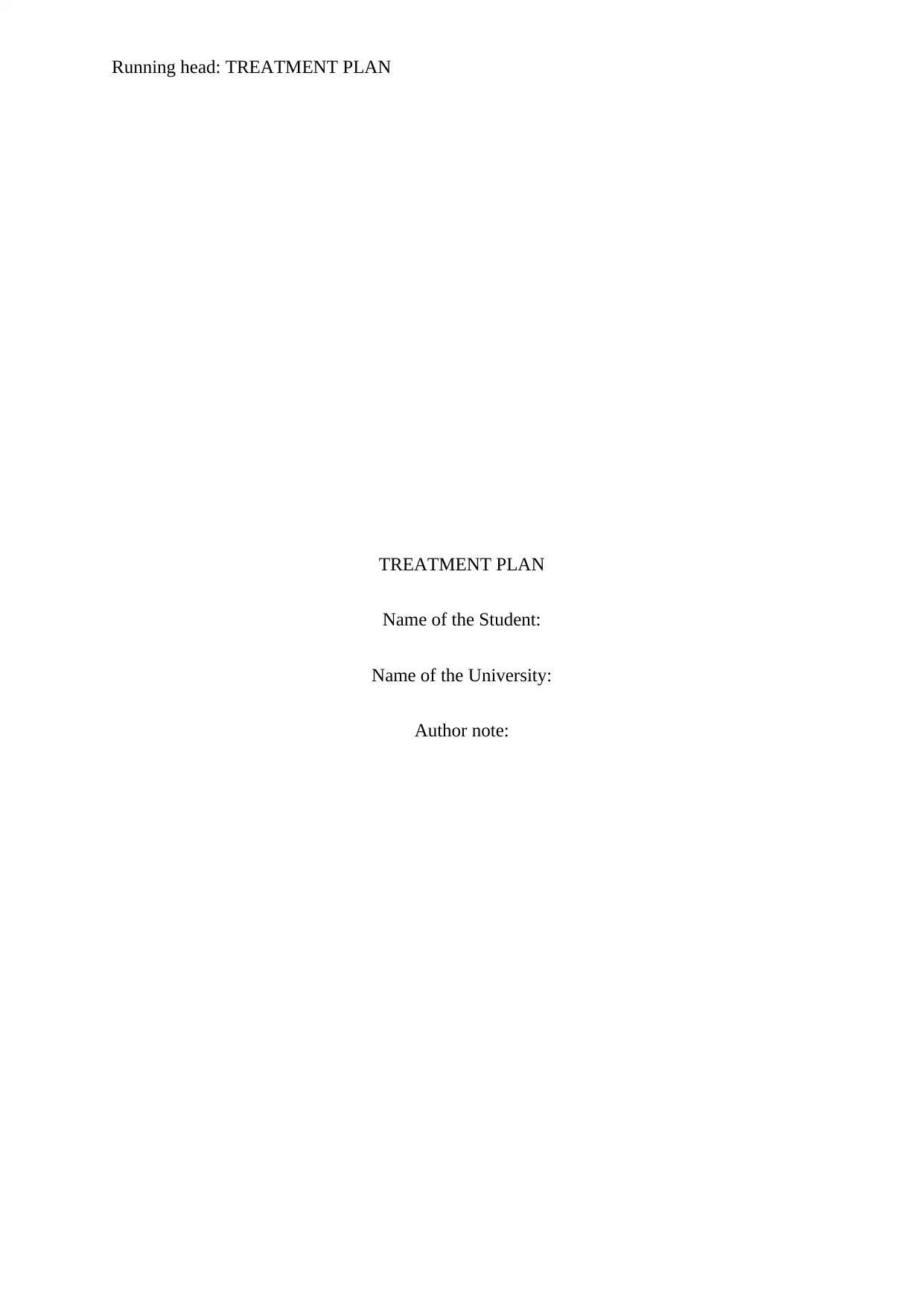
Running head: TREATMENT PLAN
TREATMENT PLAN
Name of the Student:
Name of the University:
Author note:
TREATMENT PLAN
Name of the Student:
Name of the University:
Author note:
Paraphrase This Document
Need a fresh take? Get an instant paraphrase of this document with our AI Paraphraser
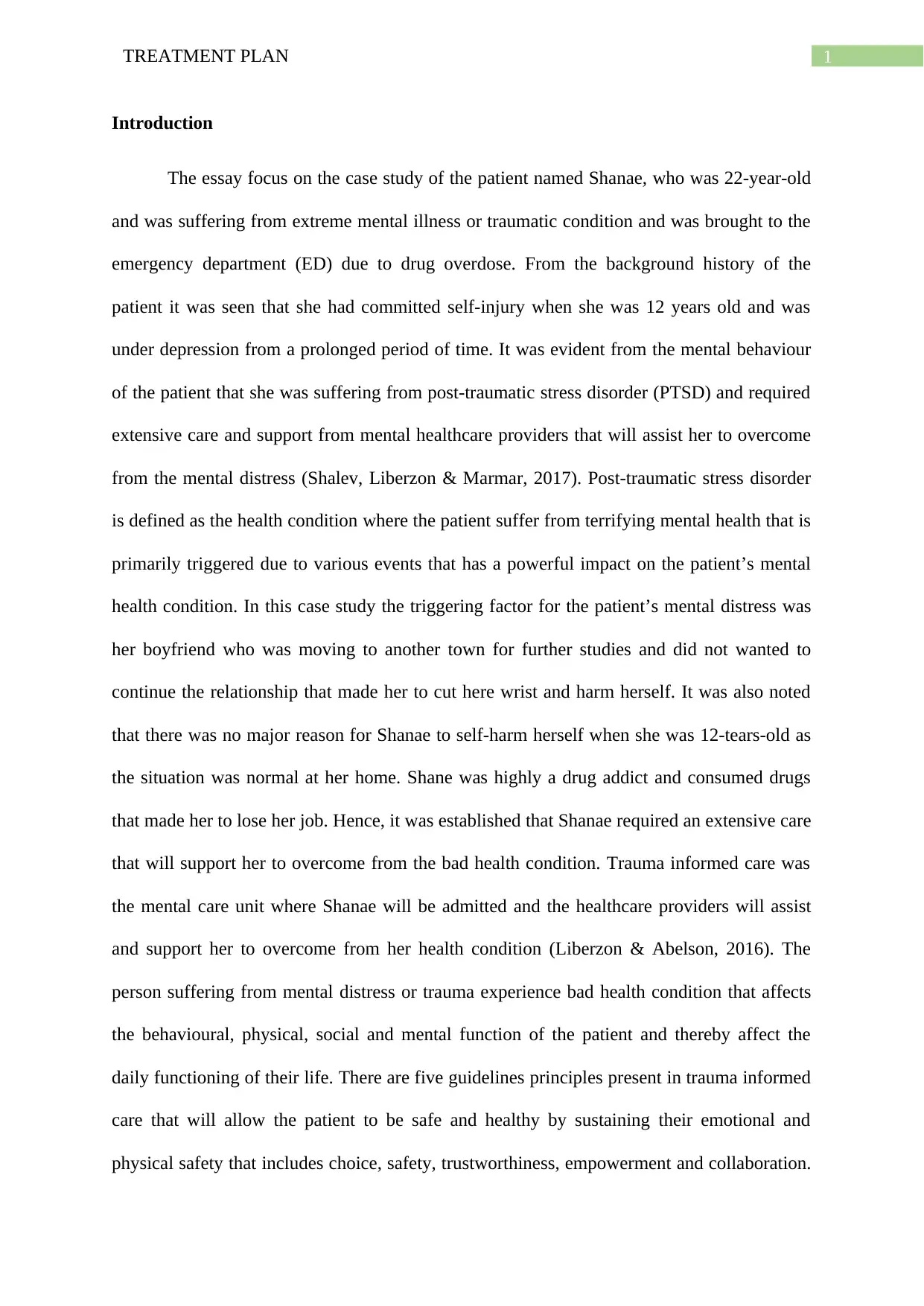
1TREATMENT PLAN
Introduction
The essay focus on the case study of the patient named Shanae, who was 22-year-old
and was suffering from extreme mental illness or traumatic condition and was brought to the
emergency department (ED) due to drug overdose. From the background history of the
patient it was seen that she had committed self-injury when she was 12 years old and was
under depression from a prolonged period of time. It was evident from the mental behaviour
of the patient that she was suffering from post-traumatic stress disorder (PTSD) and required
extensive care and support from mental healthcare providers that will assist her to overcome
from the mental distress (Shalev, Liberzon & Marmar, 2017). Post-traumatic stress disorder
is defined as the health condition where the patient suffer from terrifying mental health that is
primarily triggered due to various events that has a powerful impact on the patient’s mental
health condition. In this case study the triggering factor for the patient’s mental distress was
her boyfriend who was moving to another town for further studies and did not wanted to
continue the relationship that made her to cut here wrist and harm herself. It was also noted
that there was no major reason for Shanae to self-harm herself when she was 12-tears-old as
the situation was normal at her home. Shane was highly a drug addict and consumed drugs
that made her to lose her job. Hence, it was established that Shanae required an extensive care
that will support her to overcome from the bad health condition. Trauma informed care was
the mental care unit where Shanae will be admitted and the healthcare providers will assist
and support her to overcome from her health condition (Liberzon & Abelson, 2016). The
person suffering from mental distress or trauma experience bad health condition that affects
the behavioural, physical, social and mental function of the patient and thereby affect the
daily functioning of their life. There are five guidelines principles present in trauma informed
care that will allow the patient to be safe and healthy by sustaining their emotional and
physical safety that includes choice, safety, trustworthiness, empowerment and collaboration.
Introduction
The essay focus on the case study of the patient named Shanae, who was 22-year-old
and was suffering from extreme mental illness or traumatic condition and was brought to the
emergency department (ED) due to drug overdose. From the background history of the
patient it was seen that she had committed self-injury when she was 12 years old and was
under depression from a prolonged period of time. It was evident from the mental behaviour
of the patient that she was suffering from post-traumatic stress disorder (PTSD) and required
extensive care and support from mental healthcare providers that will assist her to overcome
from the mental distress (Shalev, Liberzon & Marmar, 2017). Post-traumatic stress disorder
is defined as the health condition where the patient suffer from terrifying mental health that is
primarily triggered due to various events that has a powerful impact on the patient’s mental
health condition. In this case study the triggering factor for the patient’s mental distress was
her boyfriend who was moving to another town for further studies and did not wanted to
continue the relationship that made her to cut here wrist and harm herself. It was also noted
that there was no major reason for Shanae to self-harm herself when she was 12-tears-old as
the situation was normal at her home. Shane was highly a drug addict and consumed drugs
that made her to lose her job. Hence, it was established that Shanae required an extensive care
that will support her to overcome from the bad health condition. Trauma informed care was
the mental care unit where Shanae will be admitted and the healthcare providers will assist
and support her to overcome from her health condition (Liberzon & Abelson, 2016). The
person suffering from mental distress or trauma experience bad health condition that affects
the behavioural, physical, social and mental function of the patient and thereby affect the
daily functioning of their life. There are five guidelines principles present in trauma informed
care that will allow the patient to be safe and healthy by sustaining their emotional and
physical safety that includes choice, safety, trustworthiness, empowerment and collaboration.
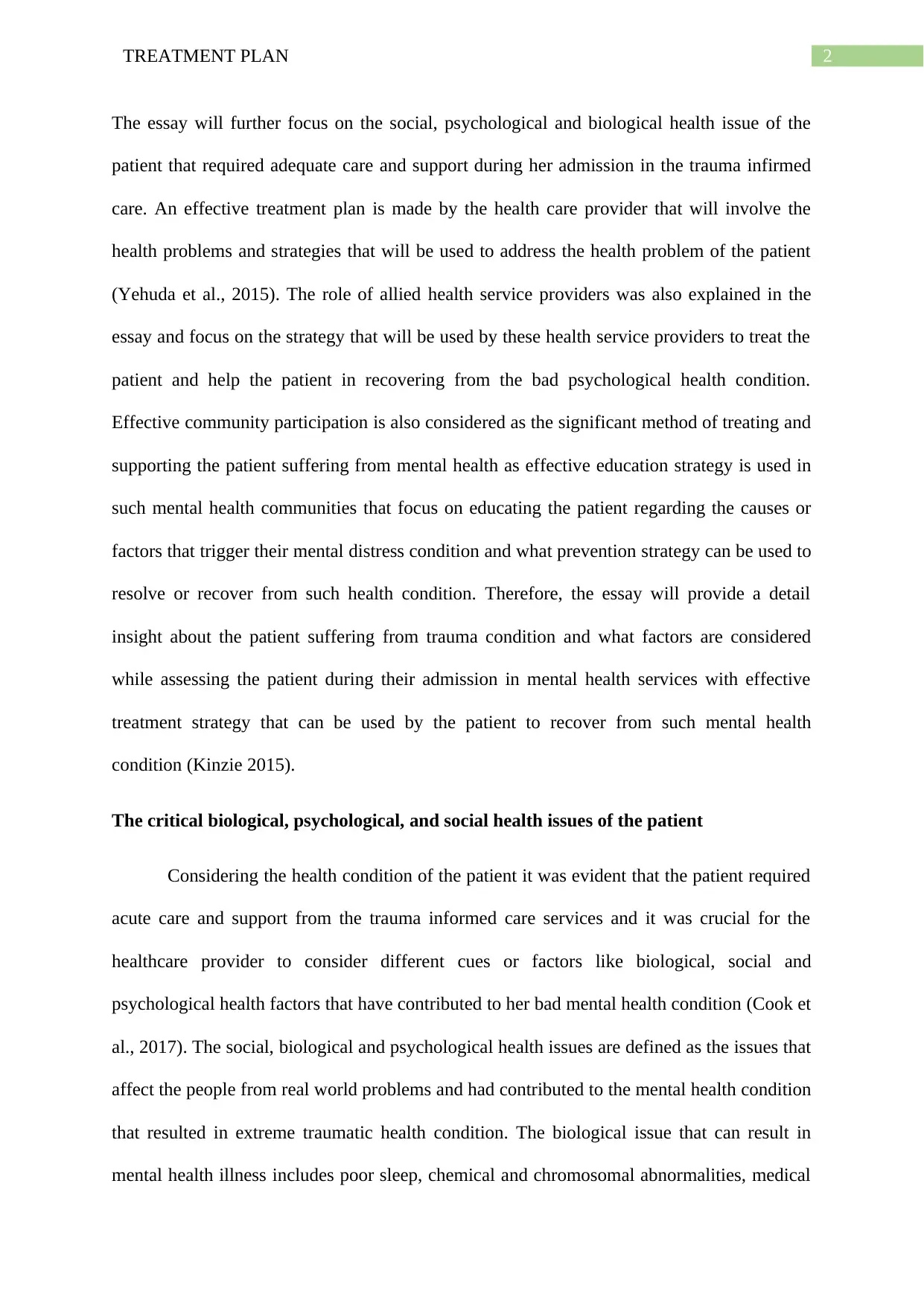
2TREATMENT PLAN
The essay will further focus on the social, psychological and biological health issue of the
patient that required adequate care and support during her admission in the trauma infirmed
care. An effective treatment plan is made by the health care provider that will involve the
health problems and strategies that will be used to address the health problem of the patient
(Yehuda et al., 2015). The role of allied health service providers was also explained in the
essay and focus on the strategy that will be used by these health service providers to treat the
patient and help the patient in recovering from the bad psychological health condition.
Effective community participation is also considered as the significant method of treating and
supporting the patient suffering from mental health as effective education strategy is used in
such mental health communities that focus on educating the patient regarding the causes or
factors that trigger their mental distress condition and what prevention strategy can be used to
resolve or recover from such health condition. Therefore, the essay will provide a detail
insight about the patient suffering from trauma condition and what factors are considered
while assessing the patient during their admission in mental health services with effective
treatment strategy that can be used by the patient to recover from such mental health
condition (Kinzie 2015).
The critical biological, psychological, and social health issues of the patient
Considering the health condition of the patient it was evident that the patient required
acute care and support from the trauma informed care services and it was crucial for the
healthcare provider to consider different cues or factors like biological, social and
psychological health factors that have contributed to her bad mental health condition (Cook et
al., 2017). The social, biological and psychological health issues are defined as the issues that
affect the people from real world problems and had contributed to the mental health condition
that resulted in extreme traumatic health condition. The biological issue that can result in
mental health illness includes poor sleep, chemical and chromosomal abnormalities, medical
The essay will further focus on the social, psychological and biological health issue of the
patient that required adequate care and support during her admission in the trauma infirmed
care. An effective treatment plan is made by the health care provider that will involve the
health problems and strategies that will be used to address the health problem of the patient
(Yehuda et al., 2015). The role of allied health service providers was also explained in the
essay and focus on the strategy that will be used by these health service providers to treat the
patient and help the patient in recovering from the bad psychological health condition.
Effective community participation is also considered as the significant method of treating and
supporting the patient suffering from mental health as effective education strategy is used in
such mental health communities that focus on educating the patient regarding the causes or
factors that trigger their mental distress condition and what prevention strategy can be used to
resolve or recover from such health condition. Therefore, the essay will provide a detail
insight about the patient suffering from trauma condition and what factors are considered
while assessing the patient during their admission in mental health services with effective
treatment strategy that can be used by the patient to recover from such mental health
condition (Kinzie 2015).
The critical biological, psychological, and social health issues of the patient
Considering the health condition of the patient it was evident that the patient required
acute care and support from the trauma informed care services and it was crucial for the
healthcare provider to consider different cues or factors like biological, social and
psychological health factors that have contributed to her bad mental health condition (Cook et
al., 2017). The social, biological and psychological health issues are defined as the issues that
affect the people from real world problems and had contributed to the mental health condition
that resulted in extreme traumatic health condition. The biological issue that can result in
mental health illness includes poor sleep, chemical and chromosomal abnormalities, medical
⊘ This is a preview!⊘
Do you want full access?
Subscribe today to unlock all pages.

Trusted by 1+ million students worldwide
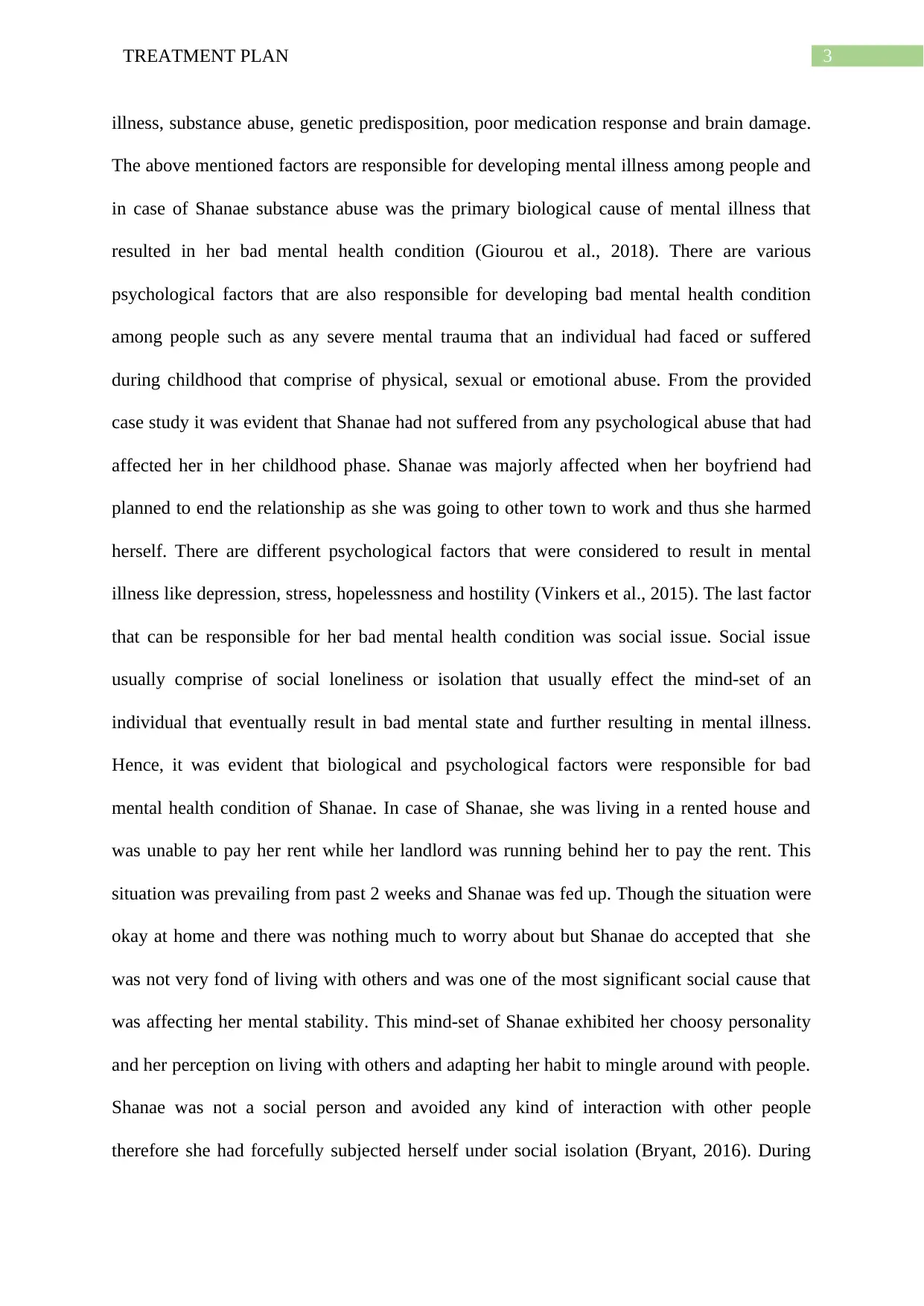
3TREATMENT PLAN
illness, substance abuse, genetic predisposition, poor medication response and brain damage.
The above mentioned factors are responsible for developing mental illness among people and
in case of Shanae substance abuse was the primary biological cause of mental illness that
resulted in her bad mental health condition (Giourou et al., 2018). There are various
psychological factors that are also responsible for developing bad mental health condition
among people such as any severe mental trauma that an individual had faced or suffered
during childhood that comprise of physical, sexual or emotional abuse. From the provided
case study it was evident that Shanae had not suffered from any psychological abuse that had
affected her in her childhood phase. Shanae was majorly affected when her boyfriend had
planned to end the relationship as she was going to other town to work and thus she harmed
herself. There are different psychological factors that were considered to result in mental
illness like depression, stress, hopelessness and hostility (Vinkers et al., 2015). The last factor
that can be responsible for her bad mental health condition was social issue. Social issue
usually comprise of social loneliness or isolation that usually effect the mind-set of an
individual that eventually result in bad mental state and further resulting in mental illness.
Hence, it was evident that biological and psychological factors were responsible for bad
mental health condition of Shanae. In case of Shanae, she was living in a rented house and
was unable to pay her rent while her landlord was running behind her to pay the rent. This
situation was prevailing from past 2 weeks and Shanae was fed up. Though the situation were
okay at home and there was nothing much to worry about but Shanae do accepted that she
was not very fond of living with others and was one of the most significant social cause that
was affecting her mental stability. This mind-set of Shanae exhibited her choosy personality
and her perception on living with others and adapting her habit to mingle around with people.
Shanae was not a social person and avoided any kind of interaction with other people
therefore she had forcefully subjected herself under social isolation (Bryant, 2016). During
illness, substance abuse, genetic predisposition, poor medication response and brain damage.
The above mentioned factors are responsible for developing mental illness among people and
in case of Shanae substance abuse was the primary biological cause of mental illness that
resulted in her bad mental health condition (Giourou et al., 2018). There are various
psychological factors that are also responsible for developing bad mental health condition
among people such as any severe mental trauma that an individual had faced or suffered
during childhood that comprise of physical, sexual or emotional abuse. From the provided
case study it was evident that Shanae had not suffered from any psychological abuse that had
affected her in her childhood phase. Shanae was majorly affected when her boyfriend had
planned to end the relationship as she was going to other town to work and thus she harmed
herself. There are different psychological factors that were considered to result in mental
illness like depression, stress, hopelessness and hostility (Vinkers et al., 2015). The last factor
that can be responsible for her bad mental health condition was social issue. Social issue
usually comprise of social loneliness or isolation that usually effect the mind-set of an
individual that eventually result in bad mental state and further resulting in mental illness.
Hence, it was evident that biological and psychological factors were responsible for bad
mental health condition of Shanae. In case of Shanae, she was living in a rented house and
was unable to pay her rent while her landlord was running behind her to pay the rent. This
situation was prevailing from past 2 weeks and Shanae was fed up. Though the situation were
okay at home and there was nothing much to worry about but Shanae do accepted that she
was not very fond of living with others and was one of the most significant social cause that
was affecting her mental stability. This mind-set of Shanae exhibited her choosy personality
and her perception on living with others and adapting her habit to mingle around with people.
Shanae was not a social person and avoided any kind of interaction with other people
therefore she had forcefully subjected herself under social isolation (Bryant, 2016). During
Paraphrase This Document
Need a fresh take? Get an instant paraphrase of this document with our AI Paraphraser
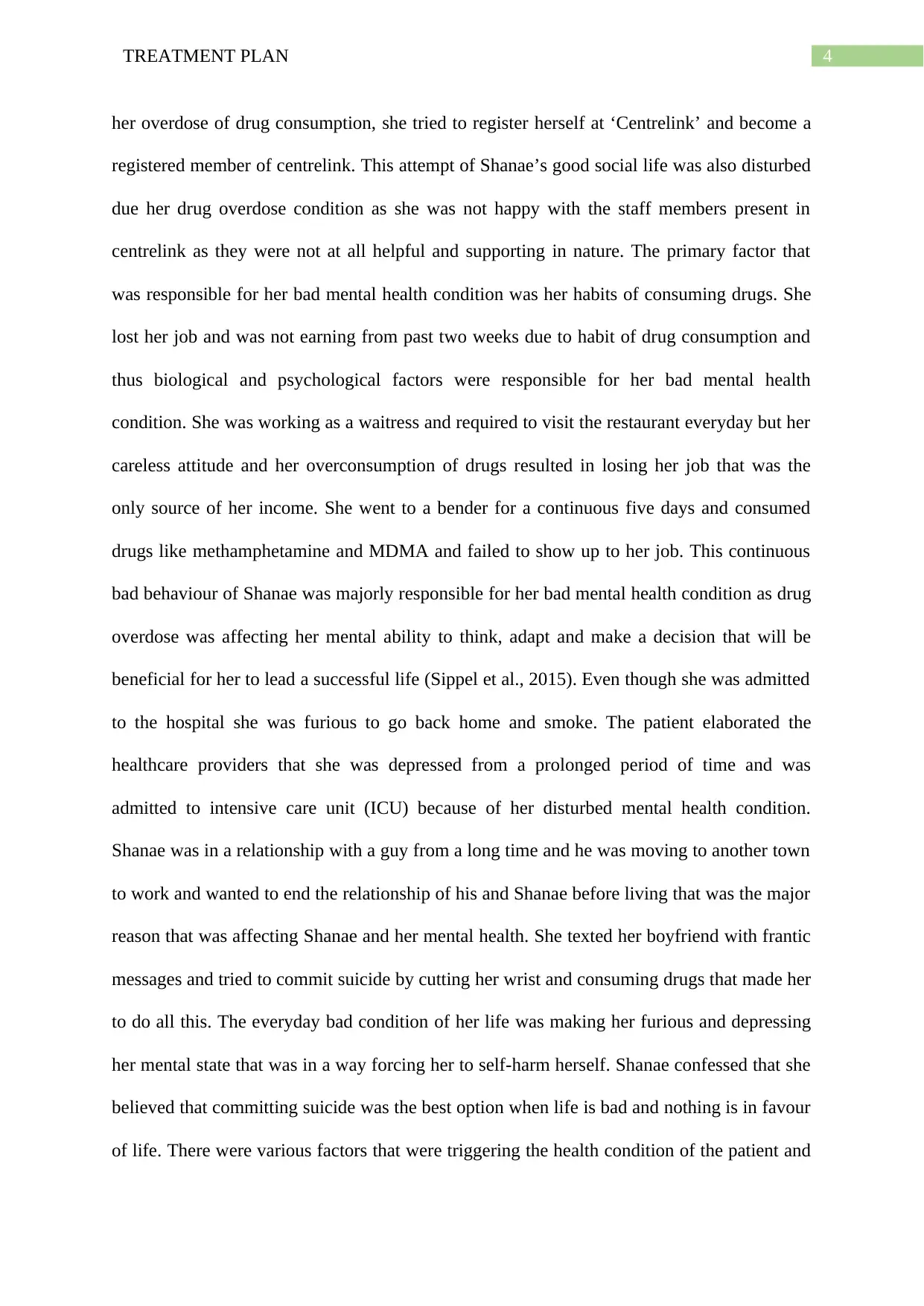
4TREATMENT PLAN
her overdose of drug consumption, she tried to register herself at ‘Centrelink’ and become a
registered member of centrelink. This attempt of Shanae’s good social life was also disturbed
due her drug overdose condition as she was not happy with the staff members present in
centrelink as they were not at all helpful and supporting in nature. The primary factor that
was responsible for her bad mental health condition was her habits of consuming drugs. She
lost her job and was not earning from past two weeks due to habit of drug consumption and
thus biological and psychological factors were responsible for her bad mental health
condition. She was working as a waitress and required to visit the restaurant everyday but her
careless attitude and her overconsumption of drugs resulted in losing her job that was the
only source of her income. She went to a bender for a continuous five days and consumed
drugs like methamphetamine and MDMA and failed to show up to her job. This continuous
bad behaviour of Shanae was majorly responsible for her bad mental health condition as drug
overdose was affecting her mental ability to think, adapt and make a decision that will be
beneficial for her to lead a successful life (Sippel et al., 2015). Even though she was admitted
to the hospital she was furious to go back home and smoke. The patient elaborated the
healthcare providers that she was depressed from a prolonged period of time and was
admitted to intensive care unit (ICU) because of her disturbed mental health condition.
Shanae was in a relationship with a guy from a long time and he was moving to another town
to work and wanted to end the relationship of his and Shanae before living that was the major
reason that was affecting Shanae and her mental health. She texted her boyfriend with frantic
messages and tried to commit suicide by cutting her wrist and consuming drugs that made her
to do all this. The everyday bad condition of her life was making her furious and depressing
her mental state that was in a way forcing her to self-harm herself. Shanae confessed that she
believed that committing suicide was the best option when life is bad and nothing is in favour
of life. There were various factors that were triggering the health condition of the patient and
her overdose of drug consumption, she tried to register herself at ‘Centrelink’ and become a
registered member of centrelink. This attempt of Shanae’s good social life was also disturbed
due her drug overdose condition as she was not happy with the staff members present in
centrelink as they were not at all helpful and supporting in nature. The primary factor that
was responsible for her bad mental health condition was her habits of consuming drugs. She
lost her job and was not earning from past two weeks due to habit of drug consumption and
thus biological and psychological factors were responsible for her bad mental health
condition. She was working as a waitress and required to visit the restaurant everyday but her
careless attitude and her overconsumption of drugs resulted in losing her job that was the
only source of her income. She went to a bender for a continuous five days and consumed
drugs like methamphetamine and MDMA and failed to show up to her job. This continuous
bad behaviour of Shanae was majorly responsible for her bad mental health condition as drug
overdose was affecting her mental ability to think, adapt and make a decision that will be
beneficial for her to lead a successful life (Sippel et al., 2015). Even though she was admitted
to the hospital she was furious to go back home and smoke. The patient elaborated the
healthcare providers that she was depressed from a prolonged period of time and was
admitted to intensive care unit (ICU) because of her disturbed mental health condition.
Shanae was in a relationship with a guy from a long time and he was moving to another town
to work and wanted to end the relationship of his and Shanae before living that was the major
reason that was affecting Shanae and her mental health. She texted her boyfriend with frantic
messages and tried to commit suicide by cutting her wrist and consuming drugs that made her
to do all this. The everyday bad condition of her life was making her furious and depressing
her mental state that was in a way forcing her to self-harm herself. Shanae confessed that she
believed that committing suicide was the best option when life is bad and nothing is in favour
of life. There were various factors that were triggering the health condition of the patient and
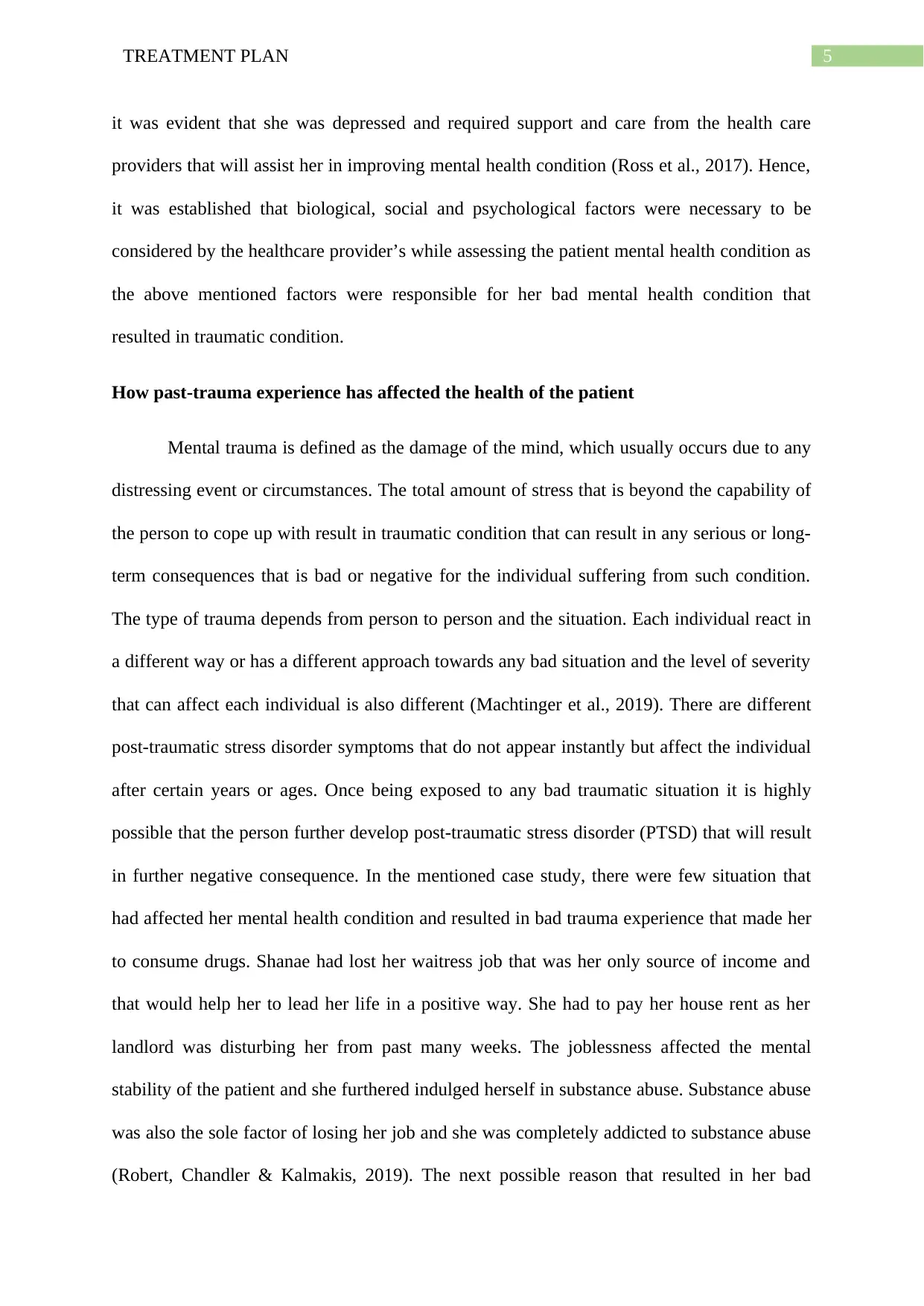
5TREATMENT PLAN
it was evident that she was depressed and required support and care from the health care
providers that will assist her in improving mental health condition (Ross et al., 2017). Hence,
it was established that biological, social and psychological factors were necessary to be
considered by the healthcare provider’s while assessing the patient mental health condition as
the above mentioned factors were responsible for her bad mental health condition that
resulted in traumatic condition.
How past-trauma experience has affected the health of the patient
Mental trauma is defined as the damage of the mind, which usually occurs due to any
distressing event or circumstances. The total amount of stress that is beyond the capability of
the person to cope up with result in traumatic condition that can result in any serious or long-
term consequences that is bad or negative for the individual suffering from such condition.
The type of trauma depends from person to person and the situation. Each individual react in
a different way or has a different approach towards any bad situation and the level of severity
that can affect each individual is also different (Machtinger et al., 2019). There are different
post-traumatic stress disorder symptoms that do not appear instantly but affect the individual
after certain years or ages. Once being exposed to any bad traumatic situation it is highly
possible that the person further develop post-traumatic stress disorder (PTSD) that will result
in further negative consequence. In the mentioned case study, there were few situation that
had affected her mental health condition and resulted in bad trauma experience that made her
to consume drugs. Shanae had lost her waitress job that was her only source of income and
that would help her to lead her life in a positive way. She had to pay her house rent as her
landlord was disturbing her from past many weeks. The joblessness affected the mental
stability of the patient and she furthered indulged herself in substance abuse. Substance abuse
was also the sole factor of losing her job and she was completely addicted to substance abuse
(Robert, Chandler & Kalmakis, 2019). The next possible reason that resulted in her bad
it was evident that she was depressed and required support and care from the health care
providers that will assist her in improving mental health condition (Ross et al., 2017). Hence,
it was established that biological, social and psychological factors were necessary to be
considered by the healthcare provider’s while assessing the patient mental health condition as
the above mentioned factors were responsible for her bad mental health condition that
resulted in traumatic condition.
How past-trauma experience has affected the health of the patient
Mental trauma is defined as the damage of the mind, which usually occurs due to any
distressing event or circumstances. The total amount of stress that is beyond the capability of
the person to cope up with result in traumatic condition that can result in any serious or long-
term consequences that is bad or negative for the individual suffering from such condition.
The type of trauma depends from person to person and the situation. Each individual react in
a different way or has a different approach towards any bad situation and the level of severity
that can affect each individual is also different (Machtinger et al., 2019). There are different
post-traumatic stress disorder symptoms that do not appear instantly but affect the individual
after certain years or ages. Once being exposed to any bad traumatic situation it is highly
possible that the person further develop post-traumatic stress disorder (PTSD) that will result
in further negative consequence. In the mentioned case study, there were few situation that
had affected her mental health condition and resulted in bad trauma experience that made her
to consume drugs. Shanae had lost her waitress job that was her only source of income and
that would help her to lead her life in a positive way. She had to pay her house rent as her
landlord was disturbing her from past many weeks. The joblessness affected the mental
stability of the patient and she furthered indulged herself in substance abuse. Substance abuse
was also the sole factor of losing her job and she was completely addicted to substance abuse
(Robert, Chandler & Kalmakis, 2019). The next possible reason that resulted in her bad
⊘ This is a preview!⊘
Do you want full access?
Subscribe today to unlock all pages.

Trusted by 1+ million students worldwide
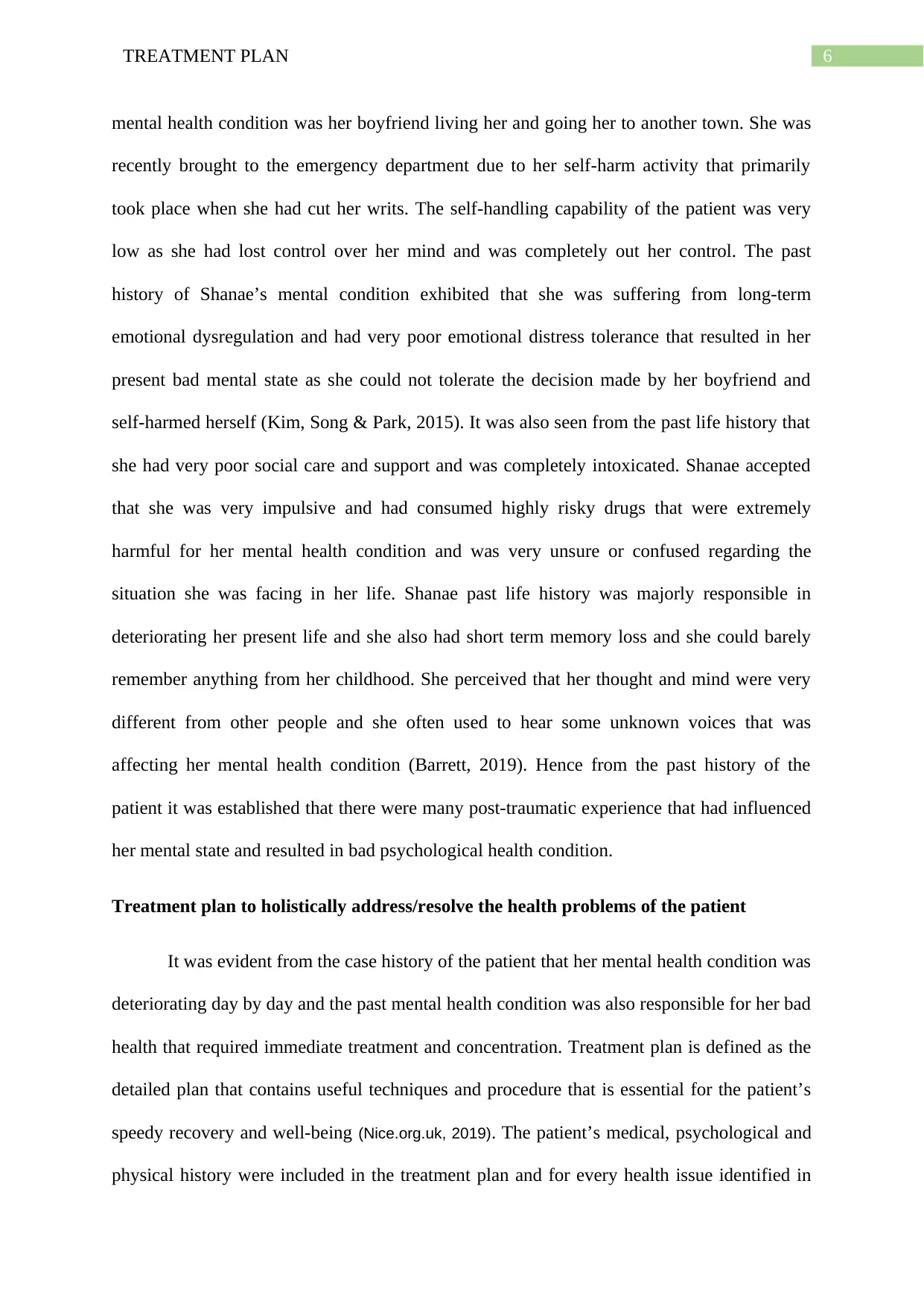
6TREATMENT PLAN
mental health condition was her boyfriend living her and going her to another town. She was
recently brought to the emergency department due to her self-harm activity that primarily
took place when she had cut her writs. The self-handling capability of the patient was very
low as she had lost control over her mind and was completely out her control. The past
history of Shanae’s mental condition exhibited that she was suffering from long-term
emotional dysregulation and had very poor emotional distress tolerance that resulted in her
present bad mental state as she could not tolerate the decision made by her boyfriend and
self-harmed herself (Kim, Song & Park, 2015). It was also seen from the past life history that
she had very poor social care and support and was completely intoxicated. Shanae accepted
that she was very impulsive and had consumed highly risky drugs that were extremely
harmful for her mental health condition and was very unsure or confused regarding the
situation she was facing in her life. Shanae past life history was majorly responsible in
deteriorating her present life and she also had short term memory loss and she could barely
remember anything from her childhood. She perceived that her thought and mind were very
different from other people and she often used to hear some unknown voices that was
affecting her mental health condition (Barrett, 2019). Hence from the past history of the
patient it was established that there were many post-traumatic experience that had influenced
her mental state and resulted in bad psychological health condition.
Treatment plan to holistically address/resolve the health problems of the patient
It was evident from the case history of the patient that her mental health condition was
deteriorating day by day and the past mental health condition was also responsible for her bad
health that required immediate treatment and concentration. Treatment plan is defined as the
detailed plan that contains useful techniques and procedure that is essential for the patient’s
speedy recovery and well-being (Nice.org.uk, 2019). The patient’s medical, psychological and
physical history were included in the treatment plan and for every health issue identified in
mental health condition was her boyfriend living her and going her to another town. She was
recently brought to the emergency department due to her self-harm activity that primarily
took place when she had cut her writs. The self-handling capability of the patient was very
low as she had lost control over her mind and was completely out her control. The past
history of Shanae’s mental condition exhibited that she was suffering from long-term
emotional dysregulation and had very poor emotional distress tolerance that resulted in her
present bad mental state as she could not tolerate the decision made by her boyfriend and
self-harmed herself (Kim, Song & Park, 2015). It was also seen from the past life history that
she had very poor social care and support and was completely intoxicated. Shanae accepted
that she was very impulsive and had consumed highly risky drugs that were extremely
harmful for her mental health condition and was very unsure or confused regarding the
situation she was facing in her life. Shanae past life history was majorly responsible in
deteriorating her present life and she also had short term memory loss and she could barely
remember anything from her childhood. She perceived that her thought and mind were very
different from other people and she often used to hear some unknown voices that was
affecting her mental health condition (Barrett, 2019). Hence from the past history of the
patient it was established that there were many post-traumatic experience that had influenced
her mental state and resulted in bad psychological health condition.
Treatment plan to holistically address/resolve the health problems of the patient
It was evident from the case history of the patient that her mental health condition was
deteriorating day by day and the past mental health condition was also responsible for her bad
health that required immediate treatment and concentration. Treatment plan is defined as the
detailed plan that contains useful techniques and procedure that is essential for the patient’s
speedy recovery and well-being (Nice.org.uk, 2019). The patient’s medical, psychological and
physical history were included in the treatment plan and for every health issue identified in
Paraphrase This Document
Need a fresh take? Get an instant paraphrase of this document with our AI Paraphraser
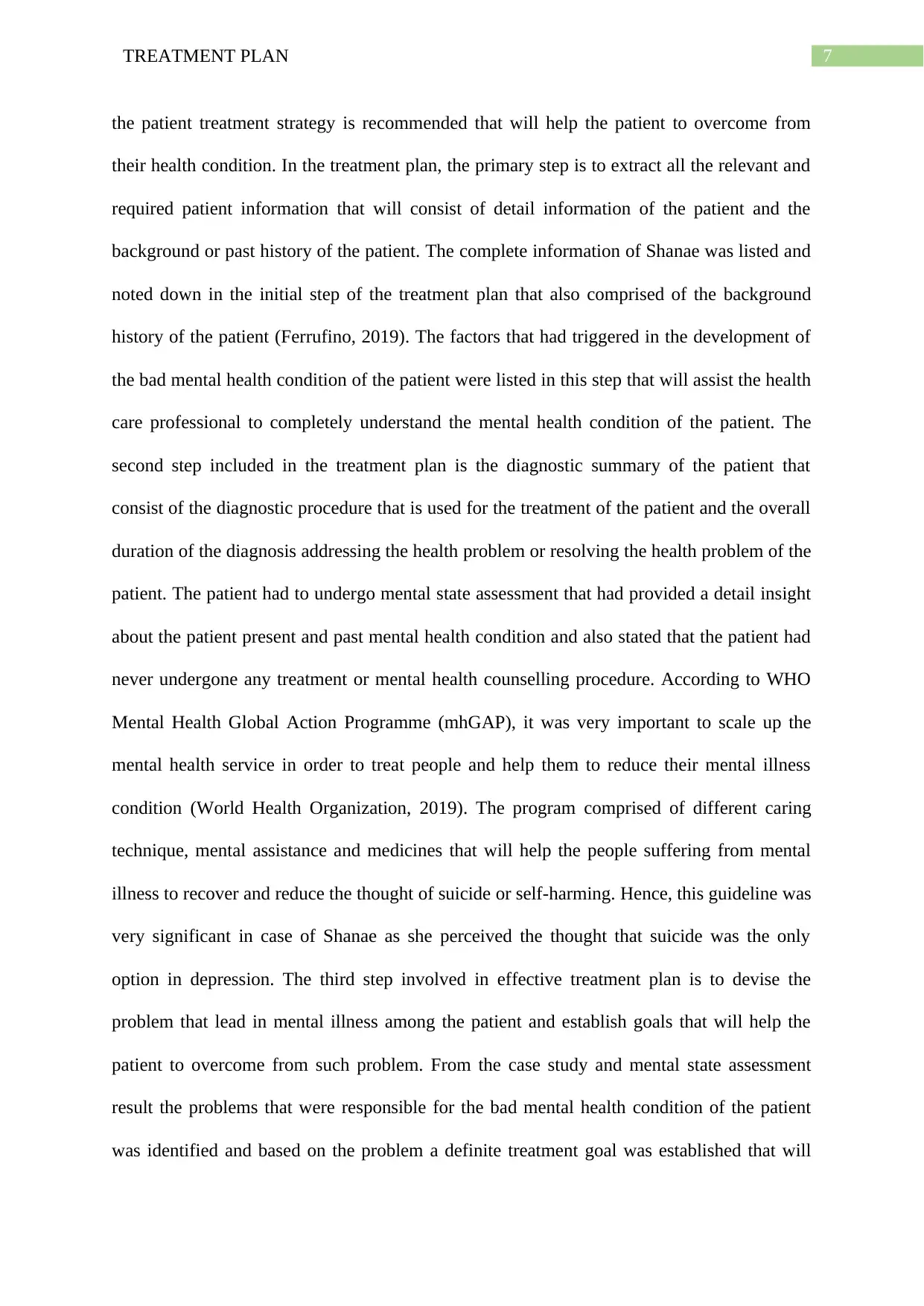
7TREATMENT PLAN
the patient treatment strategy is recommended that will help the patient to overcome from
their health condition. In the treatment plan, the primary step is to extract all the relevant and
required patient information that will consist of detail information of the patient and the
background or past history of the patient. The complete information of Shanae was listed and
noted down in the initial step of the treatment plan that also comprised of the background
history of the patient (Ferrufino, 2019). The factors that had triggered in the development of
the bad mental health condition of the patient were listed in this step that will assist the health
care professional to completely understand the mental health condition of the patient. The
second step included in the treatment plan is the diagnostic summary of the patient that
consist of the diagnostic procedure that is used for the treatment of the patient and the overall
duration of the diagnosis addressing the health problem or resolving the health problem of the
patient. The patient had to undergo mental state assessment that had provided a detail insight
about the patient present and past mental health condition and also stated that the patient had
never undergone any treatment or mental health counselling procedure. According to WHO
Mental Health Global Action Programme (mhGAP), it was very important to scale up the
mental health service in order to treat people and help them to reduce their mental illness
condition (World Health Organization, 2019). The program comprised of different caring
technique, mental assistance and medicines that will help the people suffering from mental
illness to recover and reduce the thought of suicide or self-harming. Hence, this guideline was
very significant in case of Shanae as she perceived the thought that suicide was the only
option in depression. The third step involved in effective treatment plan is to devise the
problem that lead in mental illness among the patient and establish goals that will help the
patient to overcome from such problem. From the case study and mental state assessment
result the problems that were responsible for the bad mental health condition of the patient
was identified and based on the problem a definite treatment goal was established that will
the patient treatment strategy is recommended that will help the patient to overcome from
their health condition. In the treatment plan, the primary step is to extract all the relevant and
required patient information that will consist of detail information of the patient and the
background or past history of the patient. The complete information of Shanae was listed and
noted down in the initial step of the treatment plan that also comprised of the background
history of the patient (Ferrufino, 2019). The factors that had triggered in the development of
the bad mental health condition of the patient were listed in this step that will assist the health
care professional to completely understand the mental health condition of the patient. The
second step included in the treatment plan is the diagnostic summary of the patient that
consist of the diagnostic procedure that is used for the treatment of the patient and the overall
duration of the diagnosis addressing the health problem or resolving the health problem of the
patient. The patient had to undergo mental state assessment that had provided a detail insight
about the patient present and past mental health condition and also stated that the patient had
never undergone any treatment or mental health counselling procedure. According to WHO
Mental Health Global Action Programme (mhGAP), it was very important to scale up the
mental health service in order to treat people and help them to reduce their mental illness
condition (World Health Organization, 2019). The program comprised of different caring
technique, mental assistance and medicines that will help the people suffering from mental
illness to recover and reduce the thought of suicide or self-harming. Hence, this guideline was
very significant in case of Shanae as she perceived the thought that suicide was the only
option in depression. The third step involved in effective treatment plan is to devise the
problem that lead in mental illness among the patient and establish goals that will help the
patient to overcome from such problem. From the case study and mental state assessment
result the problems that were responsible for the bad mental health condition of the patient
was identified and based on the problem a definite treatment goal was established that will
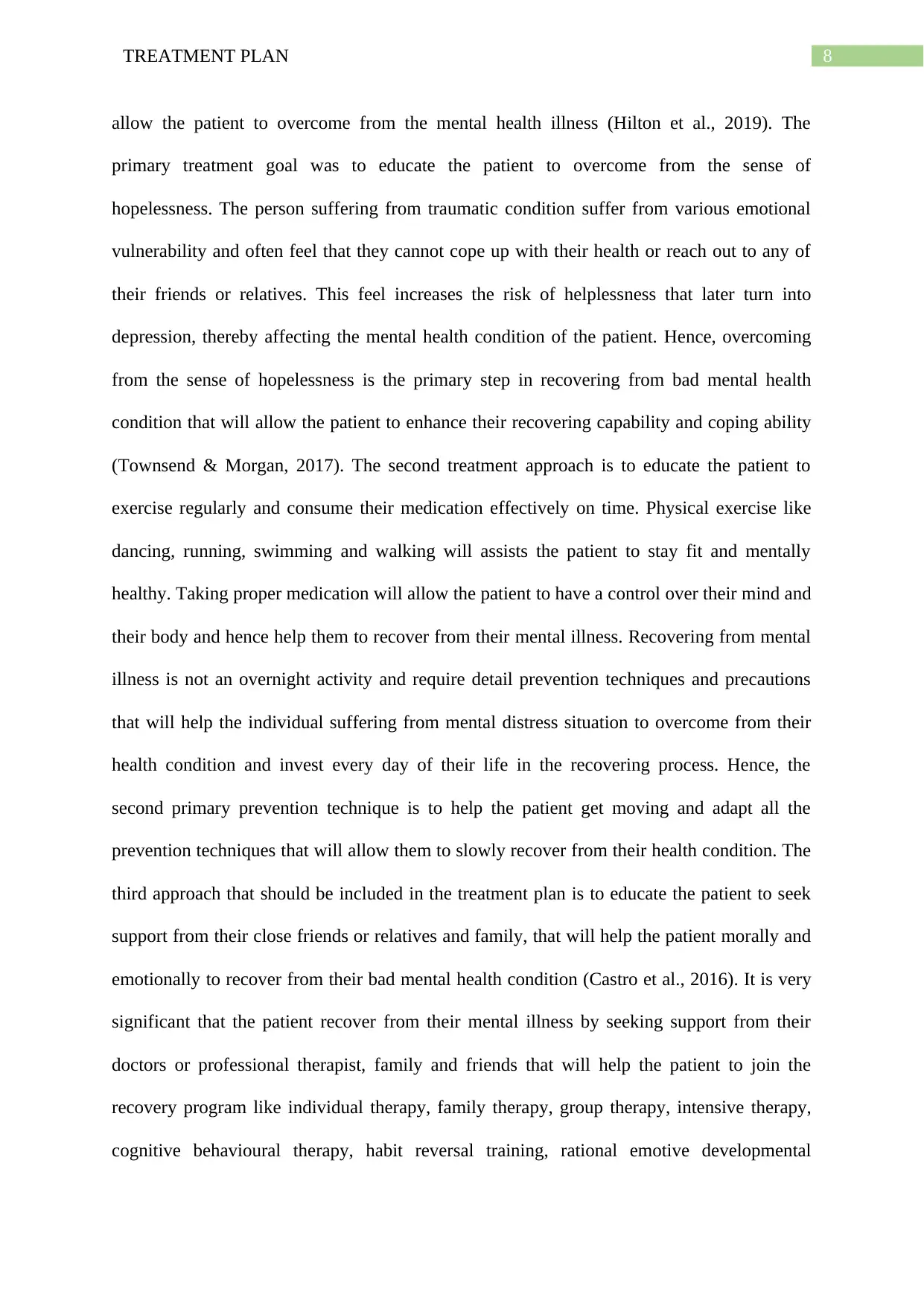
8TREATMENT PLAN
allow the patient to overcome from the mental health illness (Hilton et al., 2019). The
primary treatment goal was to educate the patient to overcome from the sense of
hopelessness. The person suffering from traumatic condition suffer from various emotional
vulnerability and often feel that they cannot cope up with their health or reach out to any of
their friends or relatives. This feel increases the risk of helplessness that later turn into
depression, thereby affecting the mental health condition of the patient. Hence, overcoming
from the sense of hopelessness is the primary step in recovering from bad mental health
condition that will allow the patient to enhance their recovering capability and coping ability
(Townsend & Morgan, 2017). The second treatment approach is to educate the patient to
exercise regularly and consume their medication effectively on time. Physical exercise like
dancing, running, swimming and walking will assists the patient to stay fit and mentally
healthy. Taking proper medication will allow the patient to have a control over their mind and
their body and hence help them to recover from their mental illness. Recovering from mental
illness is not an overnight activity and require detail prevention techniques and precautions
that will help the individual suffering from mental distress situation to overcome from their
health condition and invest every day of their life in the recovering process. Hence, the
second primary prevention technique is to help the patient get moving and adapt all the
prevention techniques that will allow them to slowly recover from their health condition. The
third approach that should be included in the treatment plan is to educate the patient to seek
support from their close friends or relatives and family, that will help the patient morally and
emotionally to recover from their bad mental health condition (Castro et al., 2016). It is very
significant that the patient recover from their mental illness by seeking support from their
doctors or professional therapist, family and friends that will help the patient to join the
recovery program like individual therapy, family therapy, group therapy, intensive therapy,
cognitive behavioural therapy, habit reversal training, rational emotive developmental
allow the patient to overcome from the mental health illness (Hilton et al., 2019). The
primary treatment goal was to educate the patient to overcome from the sense of
hopelessness. The person suffering from traumatic condition suffer from various emotional
vulnerability and often feel that they cannot cope up with their health or reach out to any of
their friends or relatives. This feel increases the risk of helplessness that later turn into
depression, thereby affecting the mental health condition of the patient. Hence, overcoming
from the sense of hopelessness is the primary step in recovering from bad mental health
condition that will allow the patient to enhance their recovering capability and coping ability
(Townsend & Morgan, 2017). The second treatment approach is to educate the patient to
exercise regularly and consume their medication effectively on time. Physical exercise like
dancing, running, swimming and walking will assists the patient to stay fit and mentally
healthy. Taking proper medication will allow the patient to have a control over their mind and
their body and hence help them to recover from their mental illness. Recovering from mental
illness is not an overnight activity and require detail prevention techniques and precautions
that will help the individual suffering from mental distress situation to overcome from their
health condition and invest every day of their life in the recovering process. Hence, the
second primary prevention technique is to help the patient get moving and adapt all the
prevention techniques that will allow them to slowly recover from their health condition. The
third approach that should be included in the treatment plan is to educate the patient to seek
support from their close friends or relatives and family, that will help the patient morally and
emotionally to recover from their bad mental health condition (Castro et al., 2016). It is very
significant that the patient recover from their mental illness by seeking support from their
doctors or professional therapist, family and friends that will help the patient to join the
recovery program like individual therapy, family therapy, group therapy, intensive therapy,
cognitive behavioural therapy, habit reversal training, rational emotive developmental
⊘ This is a preview!⊘
Do you want full access?
Subscribe today to unlock all pages.

Trusted by 1+ million students worldwide
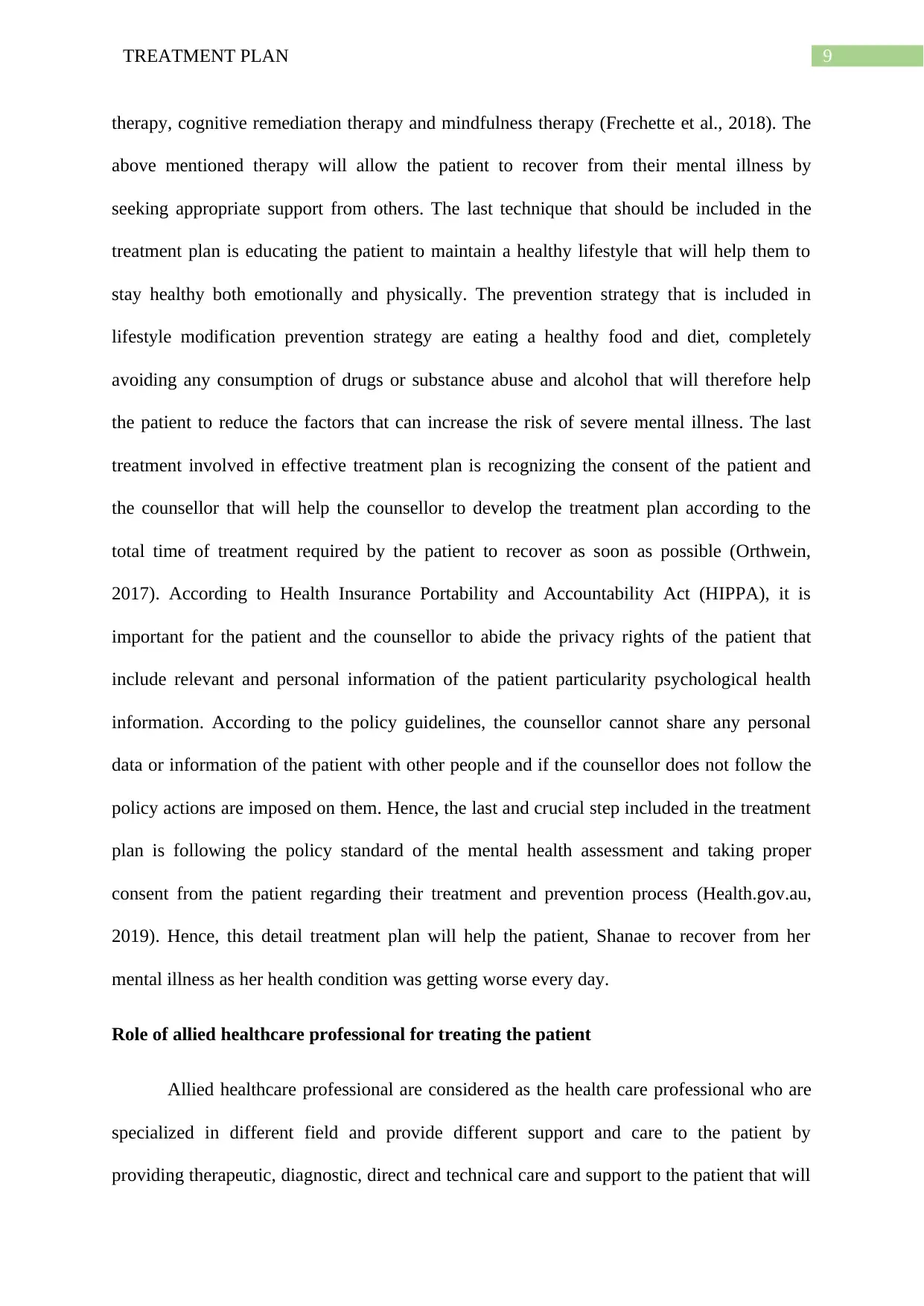
9TREATMENT PLAN
therapy, cognitive remediation therapy and mindfulness therapy (Frechette et al., 2018). The
above mentioned therapy will allow the patient to recover from their mental illness by
seeking appropriate support from others. The last technique that should be included in the
treatment plan is educating the patient to maintain a healthy lifestyle that will help them to
stay healthy both emotionally and physically. The prevention strategy that is included in
lifestyle modification prevention strategy are eating a healthy food and diet, completely
avoiding any consumption of drugs or substance abuse and alcohol that will therefore help
the patient to reduce the factors that can increase the risk of severe mental illness. The last
treatment involved in effective treatment plan is recognizing the consent of the patient and
the counsellor that will help the counsellor to develop the treatment plan according to the
total time of treatment required by the patient to recover as soon as possible (Orthwein,
2017). According to Health Insurance Portability and Accountability Act (HIPPA), it is
important for the patient and the counsellor to abide the privacy rights of the patient that
include relevant and personal information of the patient particularity psychological health
information. According to the policy guidelines, the counsellor cannot share any personal
data or information of the patient with other people and if the counsellor does not follow the
policy actions are imposed on them. Hence, the last and crucial step included in the treatment
plan is following the policy standard of the mental health assessment and taking proper
consent from the patient regarding their treatment and prevention process (Health.gov.au,
2019). Hence, this detail treatment plan will help the patient, Shanae to recover from her
mental illness as her health condition was getting worse every day.
Role of allied healthcare professional for treating the patient
Allied healthcare professional are considered as the health care professional who are
specialized in different field and provide different support and care to the patient by
providing therapeutic, diagnostic, direct and technical care and support to the patient that will
therapy, cognitive remediation therapy and mindfulness therapy (Frechette et al., 2018). The
above mentioned therapy will allow the patient to recover from their mental illness by
seeking appropriate support from others. The last technique that should be included in the
treatment plan is educating the patient to maintain a healthy lifestyle that will help them to
stay healthy both emotionally and physically. The prevention strategy that is included in
lifestyle modification prevention strategy are eating a healthy food and diet, completely
avoiding any consumption of drugs or substance abuse and alcohol that will therefore help
the patient to reduce the factors that can increase the risk of severe mental illness. The last
treatment involved in effective treatment plan is recognizing the consent of the patient and
the counsellor that will help the counsellor to develop the treatment plan according to the
total time of treatment required by the patient to recover as soon as possible (Orthwein,
2017). According to Health Insurance Portability and Accountability Act (HIPPA), it is
important for the patient and the counsellor to abide the privacy rights of the patient that
include relevant and personal information of the patient particularity psychological health
information. According to the policy guidelines, the counsellor cannot share any personal
data or information of the patient with other people and if the counsellor does not follow the
policy actions are imposed on them. Hence, the last and crucial step included in the treatment
plan is following the policy standard of the mental health assessment and taking proper
consent from the patient regarding their treatment and prevention process (Health.gov.au,
2019). Hence, this detail treatment plan will help the patient, Shanae to recover from her
mental illness as her health condition was getting worse every day.
Role of allied healthcare professional for treating the patient
Allied healthcare professional are considered as the health care professional who are
specialized in different field and provide different support and care to the patient by
providing therapeutic, diagnostic, direct and technical care and support to the patient that will
Paraphrase This Document
Need a fresh take? Get an instant paraphrase of this document with our AI Paraphraser
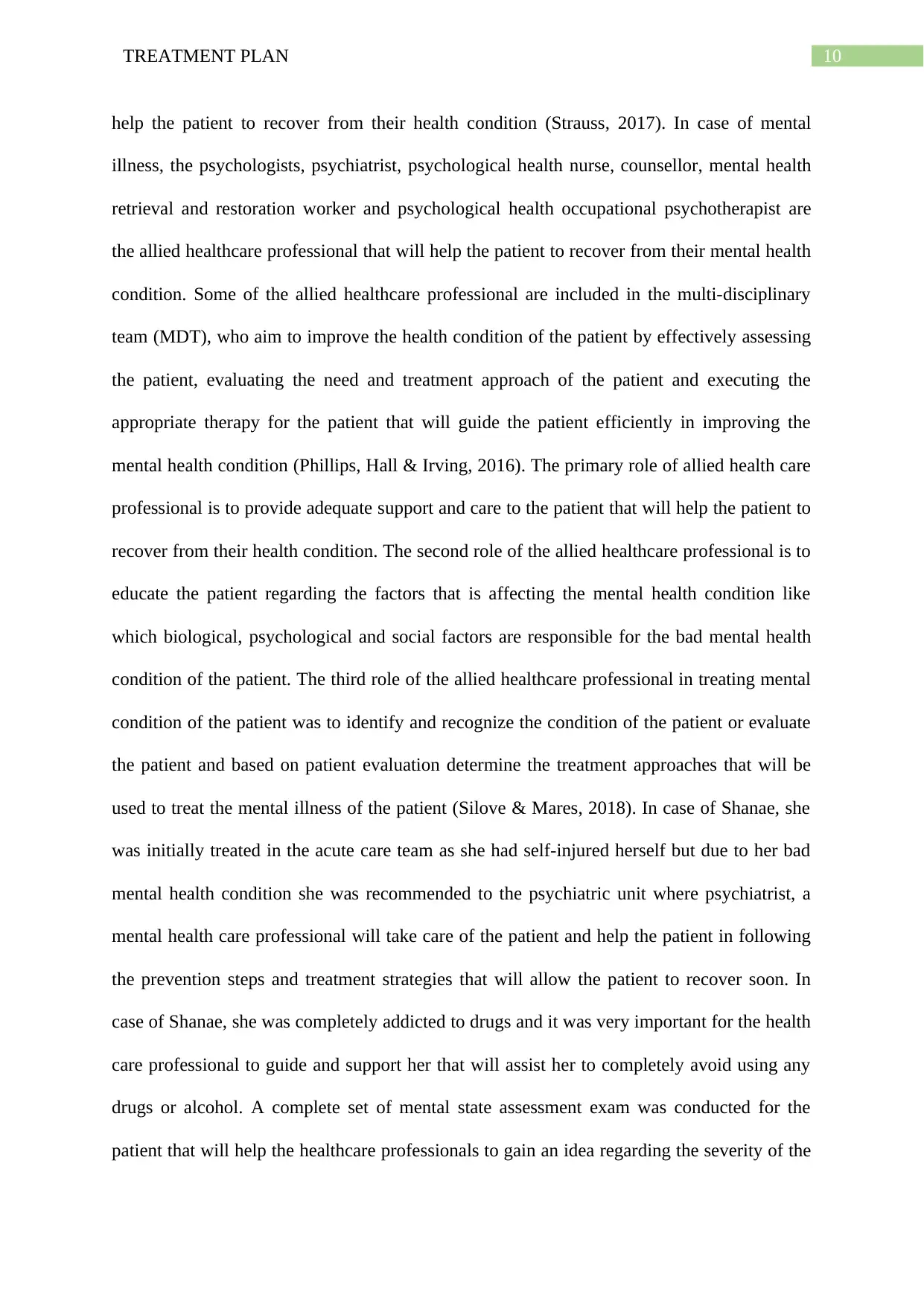
10TREATMENT PLAN
help the patient to recover from their health condition (Strauss, 2017). In case of mental
illness, the psychologists, psychiatrist, psychological health nurse, counsellor, mental health
retrieval and restoration worker and psychological health occupational psychotherapist are
the allied healthcare professional that will help the patient to recover from their mental health
condition. Some of the allied healthcare professional are included in the multi-disciplinary
team (MDT), who aim to improve the health condition of the patient by effectively assessing
the patient, evaluating the need and treatment approach of the patient and executing the
appropriate therapy for the patient that will guide the patient efficiently in improving the
mental health condition (Phillips, Hall & Irving, 2016). The primary role of allied health care
professional is to provide adequate support and care to the patient that will help the patient to
recover from their health condition. The second role of the allied healthcare professional is to
educate the patient regarding the factors that is affecting the mental health condition like
which biological, psychological and social factors are responsible for the bad mental health
condition of the patient. The third role of the allied healthcare professional in treating mental
condition of the patient was to identify and recognize the condition of the patient or evaluate
the patient and based on patient evaluation determine the treatment approaches that will be
used to treat the mental illness of the patient (Silove & Mares, 2018). In case of Shanae, she
was initially treated in the acute care team as she had self-injured herself but due to her bad
mental health condition she was recommended to the psychiatric unit where psychiatrist, a
mental health care professional will take care of the patient and help the patient in following
the prevention steps and treatment strategies that will allow the patient to recover soon. In
case of Shanae, she was completely addicted to drugs and it was very important for the health
care professional to guide and support her that will assist her to completely avoid using any
drugs or alcohol. A complete set of mental state assessment exam was conducted for the
patient that will help the healthcare professionals to gain an idea regarding the severity of the
help the patient to recover from their health condition (Strauss, 2017). In case of mental
illness, the psychologists, psychiatrist, psychological health nurse, counsellor, mental health
retrieval and restoration worker and psychological health occupational psychotherapist are
the allied healthcare professional that will help the patient to recover from their mental health
condition. Some of the allied healthcare professional are included in the multi-disciplinary
team (MDT), who aim to improve the health condition of the patient by effectively assessing
the patient, evaluating the need and treatment approach of the patient and executing the
appropriate therapy for the patient that will guide the patient efficiently in improving the
mental health condition (Phillips, Hall & Irving, 2016). The primary role of allied health care
professional is to provide adequate support and care to the patient that will help the patient to
recover from their health condition. The second role of the allied healthcare professional is to
educate the patient regarding the factors that is affecting the mental health condition like
which biological, psychological and social factors are responsible for the bad mental health
condition of the patient. The third role of the allied healthcare professional in treating mental
condition of the patient was to identify and recognize the condition of the patient or evaluate
the patient and based on patient evaluation determine the treatment approaches that will be
used to treat the mental illness of the patient (Silove & Mares, 2018). In case of Shanae, she
was initially treated in the acute care team as she had self-injured herself but due to her bad
mental health condition she was recommended to the psychiatric unit where psychiatrist, a
mental health care professional will take care of the patient and help the patient in following
the prevention steps and treatment strategies that will allow the patient to recover soon. In
case of Shanae, she was completely addicted to drugs and it was very important for the health
care professional to guide and support her that will assist her to completely avoid using any
drugs or alcohol. A complete set of mental state assessment exam was conducted for the
patient that will help the healthcare professionals to gain an idea regarding the severity of the
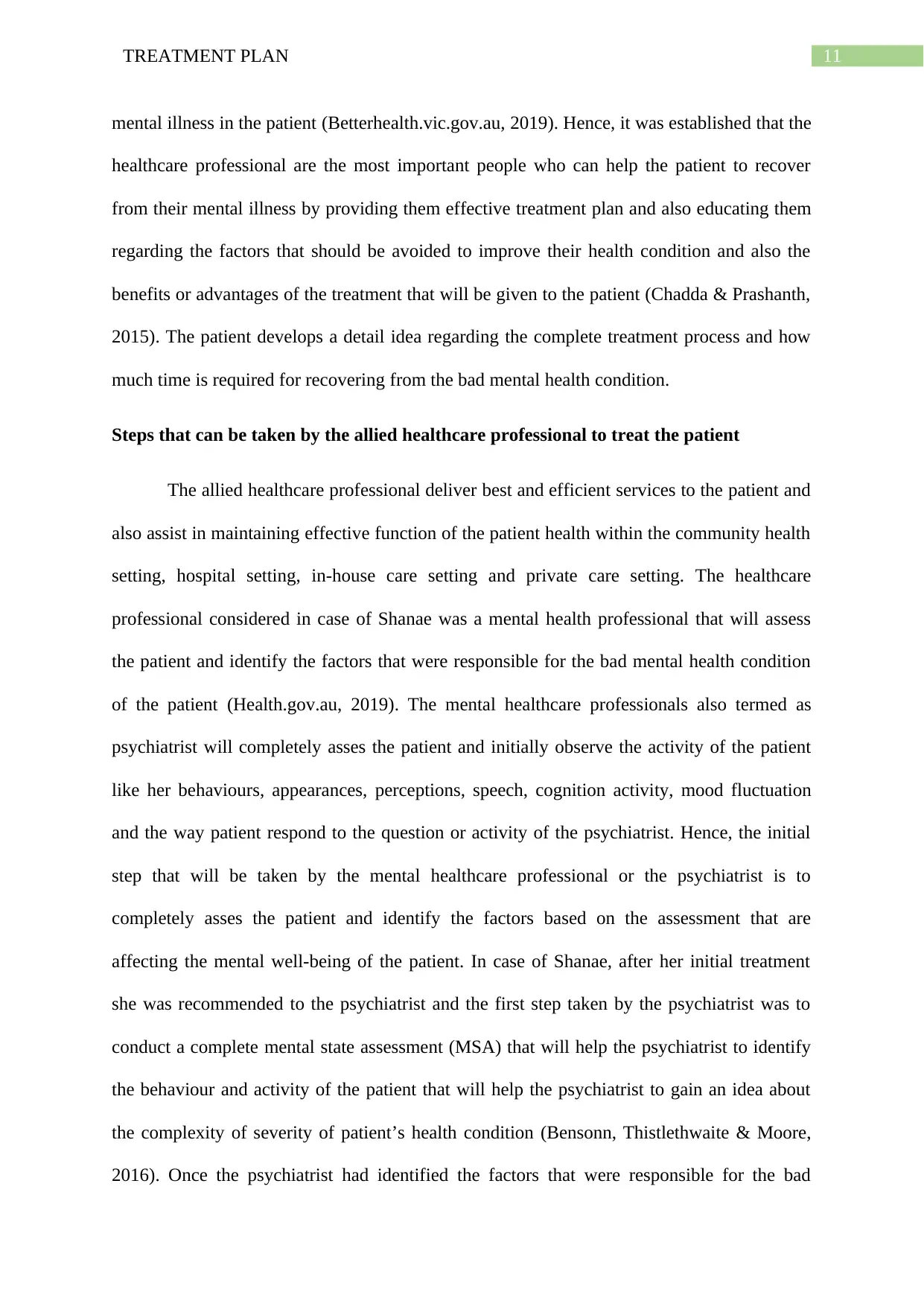
11TREATMENT PLAN
mental illness in the patient (Betterhealth.vic.gov.au, 2019). Hence, it was established that the
healthcare professional are the most important people who can help the patient to recover
from their mental illness by providing them effective treatment plan and also educating them
regarding the factors that should be avoided to improve their health condition and also the
benefits or advantages of the treatment that will be given to the patient (Chadda & Prashanth,
2015). The patient develops a detail idea regarding the complete treatment process and how
much time is required for recovering from the bad mental health condition.
Steps that can be taken by the allied healthcare professional to treat the patient
The allied healthcare professional deliver best and efficient services to the patient and
also assist in maintaining effective function of the patient health within the community health
setting, hospital setting, in-house care setting and private care setting. The healthcare
professional considered in case of Shanae was a mental health professional that will assess
the patient and identify the factors that were responsible for the bad mental health condition
of the patient (Health.gov.au, 2019). The mental healthcare professionals also termed as
psychiatrist will completely asses the patient and initially observe the activity of the patient
like her behaviours, appearances, perceptions, speech, cognition activity, mood fluctuation
and the way patient respond to the question or activity of the psychiatrist. Hence, the initial
step that will be taken by the mental healthcare professional or the psychiatrist is to
completely asses the patient and identify the factors based on the assessment that are
affecting the mental well-being of the patient. In case of Shanae, after her initial treatment
she was recommended to the psychiatrist and the first step taken by the psychiatrist was to
conduct a complete mental state assessment (MSA) that will help the psychiatrist to identify
the behaviour and activity of the patient that will help the psychiatrist to gain an idea about
the complexity of severity of patient’s health condition (Bensonn, Thistlethwaite & Moore,
2016). Once the psychiatrist had identified the factors that were responsible for the bad
mental illness in the patient (Betterhealth.vic.gov.au, 2019). Hence, it was established that the
healthcare professional are the most important people who can help the patient to recover
from their mental illness by providing them effective treatment plan and also educating them
regarding the factors that should be avoided to improve their health condition and also the
benefits or advantages of the treatment that will be given to the patient (Chadda & Prashanth,
2015). The patient develops a detail idea regarding the complete treatment process and how
much time is required for recovering from the bad mental health condition.
Steps that can be taken by the allied healthcare professional to treat the patient
The allied healthcare professional deliver best and efficient services to the patient and
also assist in maintaining effective function of the patient health within the community health
setting, hospital setting, in-house care setting and private care setting. The healthcare
professional considered in case of Shanae was a mental health professional that will assess
the patient and identify the factors that were responsible for the bad mental health condition
of the patient (Health.gov.au, 2019). The mental healthcare professionals also termed as
psychiatrist will completely asses the patient and initially observe the activity of the patient
like her behaviours, appearances, perceptions, speech, cognition activity, mood fluctuation
and the way patient respond to the question or activity of the psychiatrist. Hence, the initial
step that will be taken by the mental healthcare professional or the psychiatrist is to
completely asses the patient and identify the factors based on the assessment that are
affecting the mental well-being of the patient. In case of Shanae, after her initial treatment
she was recommended to the psychiatrist and the first step taken by the psychiatrist was to
conduct a complete mental state assessment (MSA) that will help the psychiatrist to identify
the behaviour and activity of the patient that will help the psychiatrist to gain an idea about
the complexity of severity of patient’s health condition (Bensonn, Thistlethwaite & Moore,
2016). Once the psychiatrist had identified the factors that were responsible for the bad
⊘ This is a preview!⊘
Do you want full access?
Subscribe today to unlock all pages.

Trusted by 1+ million students worldwide
1 out of 24
Related Documents
Your All-in-One AI-Powered Toolkit for Academic Success.
+13062052269
info@desklib.com
Available 24*7 on WhatsApp / Email
![[object Object]](/_next/static/media/star-bottom.7253800d.svg)
Unlock your academic potential
Copyright © 2020–2025 A2Z Services. All Rights Reserved. Developed and managed by ZUCOL.




